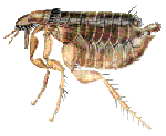The Flea
 An adult
flea is also known to be a carrier for a number of serious diseases. In the case of fleas,
it is the bubonic plague, tungiasis, or typhus that are the diseases normally causing a
person to take notice.
An adult
flea is also known to be a carrier for a number of serious diseases. In the case of fleas,
it is the bubonic plague, tungiasis, or typhus that are the diseases normally causing a
person to take notice.
Fleas deliver their dangerous baggage using a remarkable athletic ability. They can jump
nearly 100 times their own height. At adulthood, they are only the size of a pin head, so
their leaps peak out at about 12 inches. This leaping capability helps them move quickly
from host to host, or to a new hiding place for laying eggs. A single female flea lays
more than 2,000 eggs during her two-month lifespan.
Fleas are also blood thirsty creatures. If they can not find a warm-blooded animal, human
blood will do. Around the house, we are probably more familiar with the fleas carried in
by the cat or dog.
In California, the bubonic plague is the flea-carried disease of interest. It is a
bacterial infection most often resulting from a bite by an infected flea. This is the same
disease that wiped out half of the European population during the 14th century.
Since the early 1900’s, plague has been naturally present in many areas of the state.
It is maintained in a cycle between fleas and certain small rodents. These rodents are
generally immune to the effects of the disease, but have become carriers of the bacterial
infection and pass it on to new fleas.
In the absence of other warm-blooded creatures, the human being might become the recipient
of an infection from an infected flea bite. The plague can also be spread via a
person’s exposure to plague-infected rodents or plague-infected humans.
Periodically, the disease spreads via fleas into non-immune susceptible rodents, like
ground squirrels. These outbreaks usually decimate the squirrel colonies, and leave behind
hoards of infected, hungry fleas living in the vicinity of the now empty squirrel burrow.
These sites become very dangerous for unaware hunters, campers, and nearby residents.
The good news is that dryness can be fatal to fleas because they cannot retain moisture
very well. Very dry summers, and very hot temperatures (above 95 degrees F) tend to be
natural ways of reducing the flea population.
Insecticides are often used to kill the fleas around abandoned burrow systems.
Prevention Strategies — It is important to avoid infected (or uninfected) fleas, but
it also is critical to never handle sick or dead rodents without taking precautions to
prevent contact between you and the fleas in the area of the rodent.
Since it is often difficult to know when a rodent is sick and when it is not, health
officials strongly recommend that you do not handle nor feed rodents in picnic or
campground areas.
It also is important to leave your pets at home when visiting undeveloped area.
Other general prevention strategies are:
Reduce the number of fleas
Reduce the ability of the fleas to have access to humans or domestic animals.

Back to Issue - September /
October 1998
Back to 

![]()
![]()
![]()
![]()